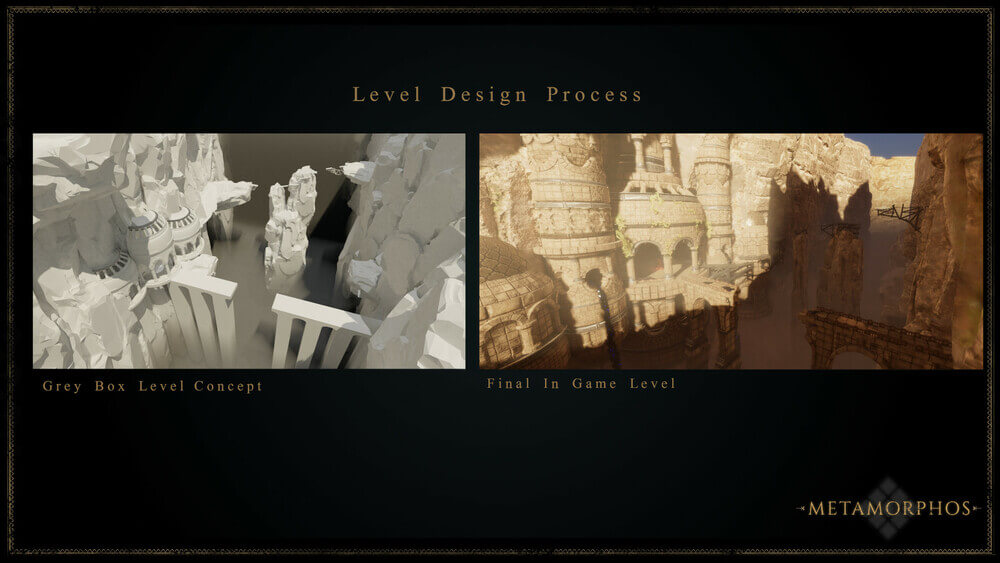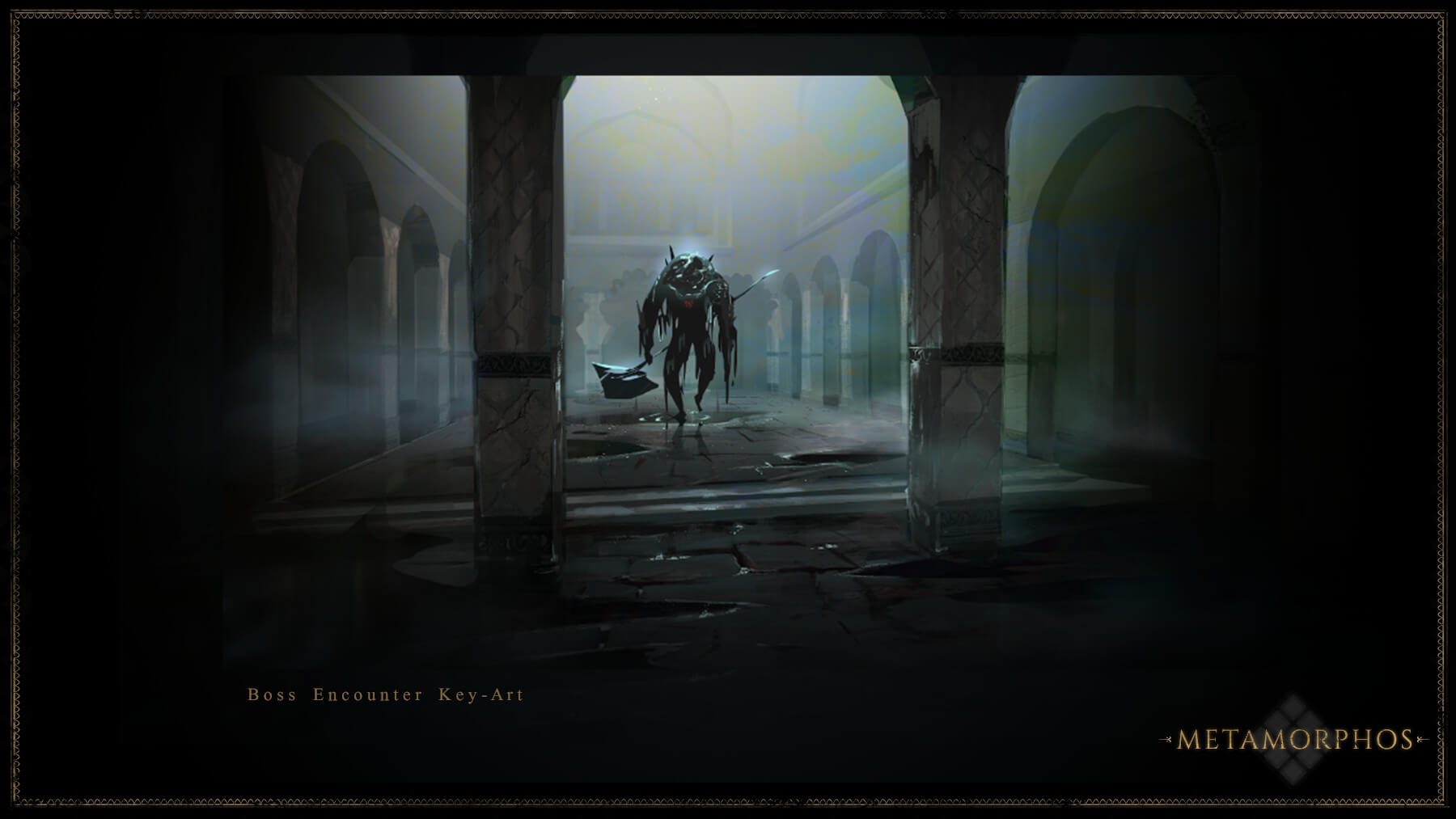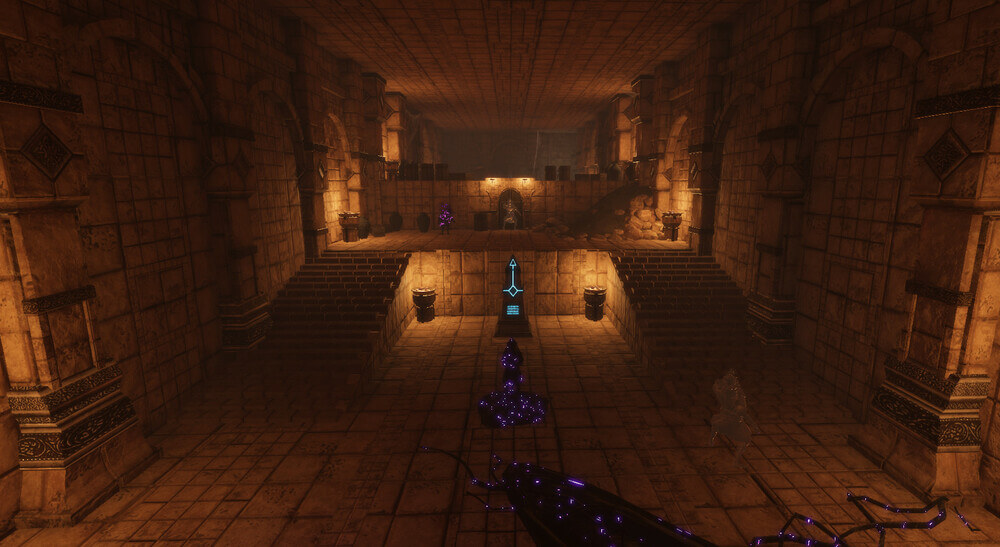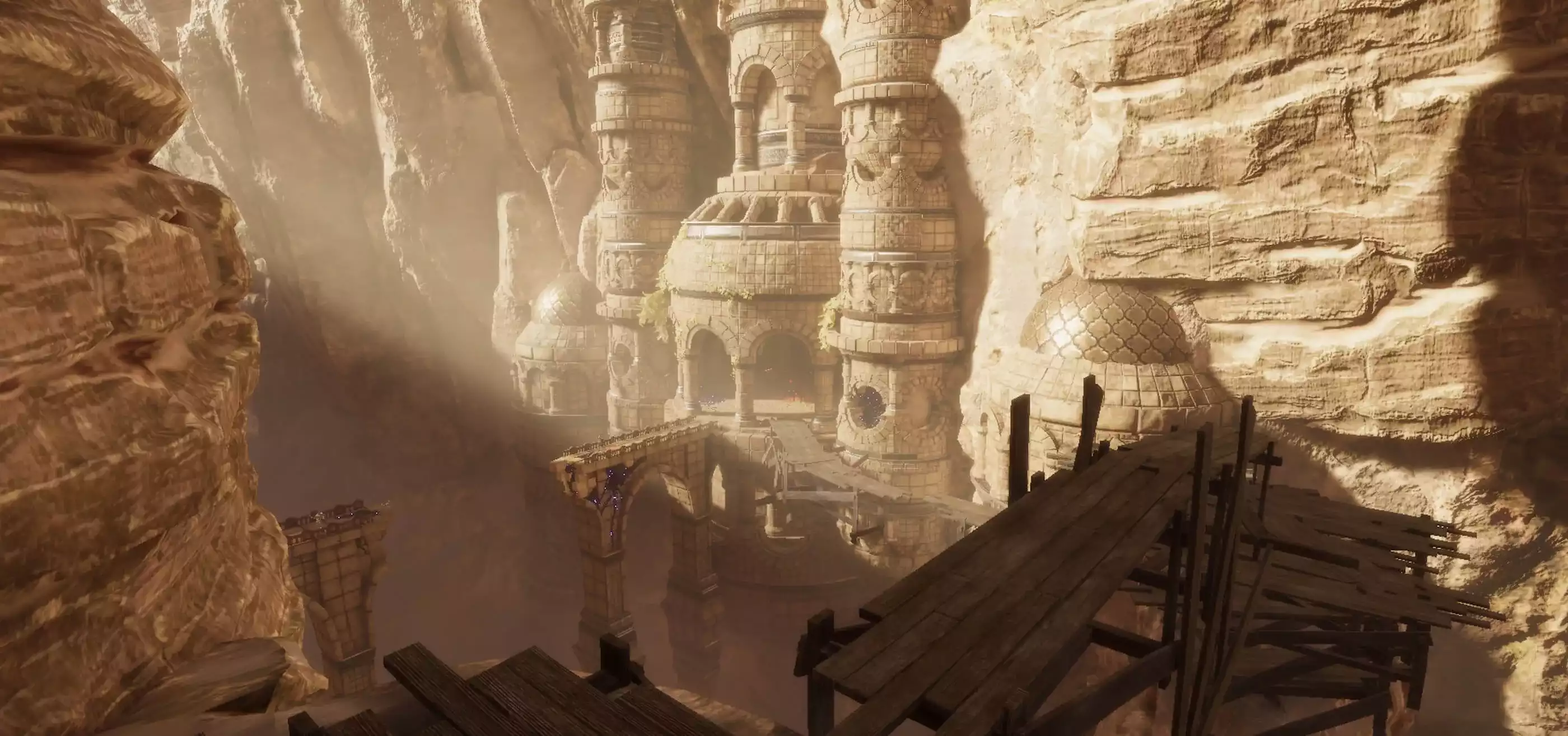There’s a running joke among gamers that in any given conversation about video games, someone will inevitably make a comparison to Dark Souls. In the case of Metamorphos, a third-person action adventure by DigiPen game team Spicy Dice Studios, such comparisons are actually welcome, according to the student creators.
“It’s definitely infused in the DNA of our game,” Arthur Bates (BFA in Digital Art and Animation), a recent 2021 graduate and the creative director for Spicy Dice Studios, says. “We’re not trying to hide it or anything.”
In Metamorphos, you play as the awakened guardian of the Temple of Amathani, which has been taken over by an evil force. Armed with a sword and the ability to dash teleport across short distances, you’ll need to slash and maneuver your way through a range of environments — including a desert canyon, abandoned marketplace, and the Temple of Amathani itself — all filled with corrupted enemies and creatures hell-bent on ending your journey.
The game was developed in the Unity engine over the course of two full academic years by a cross-disciplinary team of 26 total students. That makes it one of the largest DigiPen student game efforts — both in terms of team size and development time — to date. For Bates, however, the genesis for Metamorphos was a relatively simple one, stemming from the end of his sophomore year in 2019.
“I think the initial seed happened while I was watching the student game showcase,” he says. “There were a lot of amazing games, and I wanted to make sure that whatever team I ended up on the next year would be one of the teams where everybody’s like, ‘Oh, this is that team.’”
Bates began talking with some friends and former teammates, many of whom shared his ambitions to create something special. He even began drawing sketches for a game concept that had been germinating in his head.
“I’m a huge fan of the ‘Souls’ series and different sorts of 3D action-combat games. So I definitely wanted a game that had combat, had a lot of opportunity for art, and cool interactions with design and tech,” he says. “I was basically the spokesperson for trying to get people on board with these sketches I’d made for my idea for the game. Everybody seemed pretty enthusiastic and excited to hop on, so that’s how that all started.”
The various components of the game went through several iterations over the course of development, but the overarching concept stayed very much intact. It helped that the team could always refer back to Japanese developer From Software’s groundbreaking 2011 title, Dark Souls, as well as its direct and spiritual sequels, for guidance and inspiration.
“I think the advantage of having that as a very strong influence was that it was kind of like a master study for us as future game developers,” Bates says.

Stephen Kolodychuk (BA in Game Design), one of the combat designers on the project who later took on the role of a team producer, certainly took cues from those games when it came to crafting engaging battles.
“We probably went through a half-dozen iterations on how AI and combat worked.” Kolodychuk, who also graduated in April, says. “How do you make enemies difficult and feel interesting to fight to the players?”
Using Dark Souls as a reference point, the team tried their best to reverse engineer the tense style of melee combat found in that type of game — a process that was easier said than done. Initially, Kolodychuk says, the enemies in Metamorphos would perform a simple set of melee attacks, leaving the player free to simply walk around and avoid them as the attack animation ran its course. From there, they began to add more and more layers of complexity into the enemy combat
“We ended up with this completely dynamic tracking system, where the enemy always tries to rotate and follow the player up to a certain point, which we can set. We can set the speed on that. We can set where in the animation it starts that tracking,” Kolodychuk says. “The depth there, how far you can go into fine tuning that, has been a huge eye opener on what makes a game good.”
The Metamorphos team aimed high from the start, which made GAM class instructors leery of greenlighting the ambitious project without some parameters in place. In order to prevent the student team from biting off more than they could chew, they imposed some early restrictions. That included a limit on the number of characters and enemy types, as well as an early mandate, later rescinded, that the game could only contain either interior or exterior environments. The parameters came on top of a pre-existing grading requirement that junior-level game teams limit the scope of their project to a 15-minute experience.
“If you want to lengthen the experience, you have to make larger levels, and then you have to populate those levels with a ton of different things. You have to design more encounters. You have to tune more things. Now that you have more space and more encounters, well, you need to have more variety in your encounters, so you might want to add a new enemy,” Kolodychuk says. “The scope just balloons so quickly once you start doing that.”

All that aside, the Spicy Dice team was determined to make the game they had envisioned. As a result, they found clever ways to either work within their constraints or, in some cases, quietly sidestep them. Upon entering the second year of development, the team decided to completely overhaul the level layouts and environments for the entire game — already the second time they had done so.
“We were told going into GAM 375 that this is just supposed to be polish. Take what you have. Iterate on it. Really just make it shine. And we were like, ‘We understand that, but what if we use some deceptive images to say we’re reworking our levels, rearranging things?’” Kolodychuk says with a laugh. “I think we kept our temple entrance and our boss arena, because they were such good set pieces. And then everything else was made new, and it had a completely different flow. It was so much larger.”
“There was always kind of a back-and-forth between us and our professors,” Bates says. “We were constantly having to show our progress and be like, ‘See, we got it.’”
The team’s efforts paid off, something Metamorphos developers say was due to the dedication each person brought to the project. Kolodychuk recalls one late-night work session in which the team was all together on campus, finalizing the necessary work and bug fixes before a major milestone submission. As the group was joking about adding destructible barrels to their game, another element borrowed from Dark Souls, two team members decided to make it happen.
“Amir Azmi and Kai Oliver finished early, but they were still sticking around and being pals,” Kolodychuk says. “So while everyone’s working hard, they’re like, ‘Well, we should stay and work too.’ And they made the destructible objects that ended up being in the game.”
Looking back, the Spicy Dice team members say there were clear pros and cons to having such a large team.
“For me personally, as the creative director, I’d never been in a leadership role before,” Bates says. “So managing a team that continued to get larger over the course of its lifetime was very hard and challenging. But we did devise a system to make sure everybody was together on the same page. We had pretty frequent meetings.”
On the flip side, the large team size came with its perks. For one, individual team members could specialize on the specific skills and responsibilities that most aligned with their long-term career interests. A large team also meant the overall burden of work could more easily be carried.

“I was under the impression that it’s better to get more people on the project than fewer,” senior Aidan Staunton (BS in Computer Science in Real-Time Interactive Simulation), one of the tech leads on Metamorphos, says. “Maybe someone’s got a lot of work suddenly. That’s much better than if you have a small team, because you can spread the work around better and it’s OK if people have things that come up. It’s not going to hit the whole team as badly.”
Case in point, when the team faced a crunch-time decision on whether to polish or abandon a late-game section of content — a combat-heavy area that takes place in an aqueduct — Staunton stepped up by agreeing to take a crack at the role of set dresser. For him, it was a momentary departure from his typical experience of problem solving tech issues in Unity.
“I think we were talking about cutting a whole section of the level, and it was like, ‘Come on! Let’s just make it,’” Staunton says.
Now that Metamorphos has released on Steam, the Spicy Dice team members say they are proud to point their friends and family members to the project as proof of what they accomplished. As a part of the end credits sequence, the team members included a special thank you message to the players, acknowledging that their game was the result of “a collective 10,000 hours” of development time — a conservative estimate, Kolodychuk admits.
“Everyone at Spicy Dice has been such a talented and passionate person to work with. I’m really glad everything worked out,” he says. “It could have easily all fallen apart if people got busy, got distracted, or weren’t as passionate as they were.”
UPDATE: On March 25, 2022, Metamorphos won the 2021 Unity Award for Best Student Project. Also, during the Intel University Games Showcase 2021, Metamorphos was announced as the winner of the 1st place award for Best Visual Quality, voted on by a panel of game industry experts. You can watch a recording of the Intel showcase event on Twitch.
